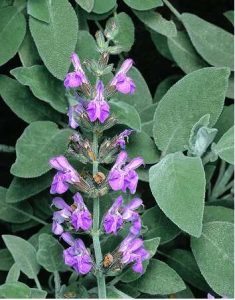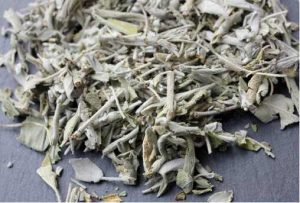Salvia officinalis, an aromatic herb of the mint family (Lamiaceae) is cultivated for its pungent edible leaves. Sage is native to the Mediterranean region and is used as a fresh or dried flavoring in many dishes, especially poultry and pork stuffings and sausages. Some varieties are also grown as ornamentals for their attractive leaves and flowers.

Several other species of the genus Salvia are also known as sage. Salvia officinalis is a perennial plant that grows to about 60 cm (2 ft) tall. The ovate leaves are rough or wrinkled and usually down; Colors range from grey-green to whitish green, and some varieties are variegated. The flowers are borne in spikes and have cylindrical two-lipped corollas that are attractive to a variety of pollinators, including bees, butterflies, and hummingbirds.
Neuroinflammation and systemic inflammation are currently one of the topics of interest in the health community. It is associated with decreased performance due to age-related risks. Several botanical ingredients have been shown to be effective in this area, including Salvia officinalis (sage), which has shown anti-inflammatory effects and has shown promising improvement in multiple human studies.

Anti-inflammatory effects have been found for Salvia officinalis across a wide set of in vitro models in human cells. Adds further evidence to support modulation of acetylcholine and monoamine neurotransmitter levels as mechanisms contributing to the herb’s health benefits.
Salvia officinalis extract has shown anti-inflammatory effects across multiple human cell lines, potentially reducing peripheral inflammation and supporting cognitive health. Salvia officinalis extract also showed the ability to inhibit enzymes related to the metabolism of monoamine neurotransmitters,

suggesting proposed cholinergic effects as well as possible dopaminergic and serotonergic effects that may mediate the acute cognitive function benefits previously demonstrated for the extract.
The role of chronic inflammation in increasing the risk of type-2 diabetes [9], cardiovascular disease [10] and various age-related health problems is well established. Inflammation plays a major role in increasing the risk of cognitive decline [11]. Neurodegenerative diseases including Alzheimer’s disease (AD) [12], Parkinson’s disease (PD) [13], multiple sclerosis (MS), and amyotrophic lateral sclerosis (ALS) [14] are commonly associated with neuroinflammation.

Salvia officinalis is a plant in the Lamiaceae family. It consists of about 900 species. Some species are used as spices or flavoring agents in the cosmetic industry [1]. Terpenoids and phenolic compounds are the most common constituents found in Salvia genus plants. Other compounds include tannins, alkaloids, fatty acids and steroids [2,3]. Several salvia species have been shown to have antioxidant, antimicrobial, anticancer, and anti-inflammatory effects [4,5,6,7].
Salvia officinalis, which has a high phenolic acid and flavonoid content, is a powerful antioxidant and anti-inflammatory herb. Inflammation plays an important role in the pathophysiology of many diseases and could cause damage by means of oxidative stress. The aim of this study was to investigate the anti-inflammatory and antioxidant activity of Salvia officinalis formed lipopolysaccharide (LPS)-induced experimental inflammation model.[8]
Reference:
-
Walker, J.B.; Sytsma, K.J. Staminal evolution in the genus Salvia (Lamiaceae): Molecular phylogenetic evidence for multiple origins of the staminal lever. Ann. Bot. 2007, 100, 375–391.
- Jakovljevi´c, M.; Joki´c, S.; Molnar, M.; Jaši´c, M.; Babi´c, J.; Juki´c, H.; Banjari, I. Bioactive profile of various Salvia officinalis L. preparations. Plants 2019, 8, 55.
- Tundis, R.; Loizzo, M.; Bonesi, M.; Leporini, M.; Menichini, F.; Passalacqua, N. A study of Salvia fruticosa Mill subsp. Thomasii (Lacaita) Brullo, Guglielmo, Pavone & Terrasi, an endemic Sage of Southern Italy. Plant Biosyst. 2018, 152, 130–141.
- Tundis, R.; Iacopetta, D.; Sinicropi, M.S.; Bonesi, M.; Leporini, M.; Passalacqua, N.G.; Ceramella, J.; Menichini, F.; Loizzo, M.R. Assessment of antioxidant, antitumor and pro-apoptotic effects of Salvia fruticosa Mill. subsp. thomasii (Lacaita) Brullo, Guglielmo, Pavone & Terrasi (Lamiaceae). Food Chem. Toxicol. 2017, 106, 155–164.
- Kolac, U.K.; Ustuner, M.C.; Tekin, N.; Ustuner, D.; Colak, E.; Entok, E. The anti-inflammatory and antioxidant effects of Salvia officinalis on lipopolysaccharide-induced inflammation in rats. J. Med. Food 2017, 20, 1193–1200.
- Zhao, J.; Lou, J.; Mou, Y.; Li, P.;Wu, J.; Zhou, L. Diterpenoid tanshinones and phenolic acids from cultured hairy roots of Salvia miltiorrhiza Bunge and their antimicrobial activities. Molecules 2011, 16, 2259–2267.
- Qnais, E.Y.; Abu-Dieyeh, M.; Abdulla, F.A.; Abdalla, S.S. The antinociceptive and anti-inflammatory effects of Salvia officinalis leaf aqueous and butanol extracts. Pharm. Biol. 2010, 48, 1149–1156.
- Umut K. K., Mehmet C. U., Neslihan T., Derya U., Emine C., Emre E. The Anti-Inflammatory and Antioxidant Effects of Salvia officinalis on Lipopolysaccharide-Induced Inflammation in Rats. Journal of Medicinal Food. 2017 Dec;20(12):1193-1200. doi: 10.1089/jmf.2017.0035.
- Lontchi-Yimagou E, Sobngwi E, Matsha TE, Kengne AP. Diabetes mellitus and inflammation. Curr Diabetes Rep. 2013;13(3):435–44.
- Ruparelia N, Chai JT, Fisher EA, Choudhury RP. Inflammatory processes in cardiovascular disease: a route to targeted therapies. Nat Rev Cardiol. 2017;14(3):133–44.
- Walker KA, Gottesman RF, Wu A, Knopman DS, Gross AL, Mosley TH, et al. Systemic inflammation during midlife and cognitive change over 20 years. Neurology. 2019;92(11):e1256–67.
- Bowman GL, Kaye JA, Moore M, Waichunas D, Carlson NE, Quinn JF. Blood-brain barrier impairment in Alzheimer disease: stability and functional significance. Neurology. 2007;68(21):1809–14.
- Gray MT, Woulfe JM. Striatal blood–brain barrier permeability in parkinson’s disease. J Cereb Blood Flow Metab. 2015;35(5):747–50.
- Zlokovic BV. The blood-brain barrier in health and chronic neurodegenerative disorders. Neuron. 2008;57(2):178–201.